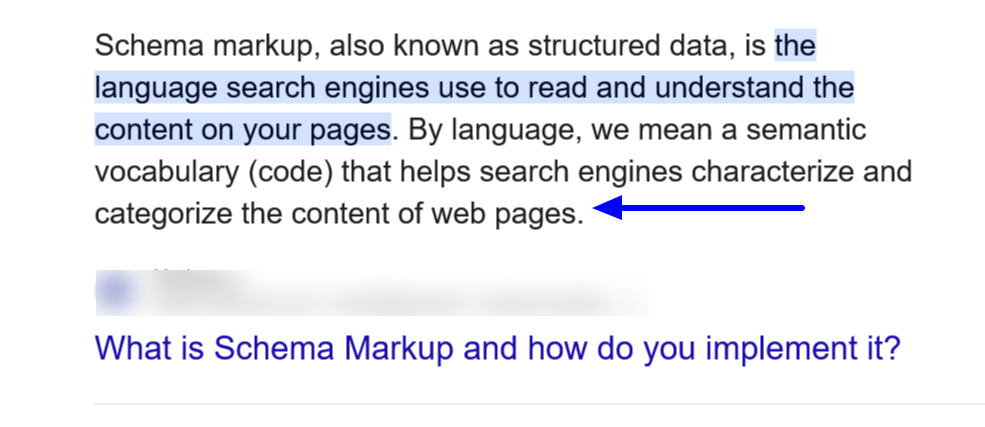Schema markup is a short code or tag to display information about the page, such as Article schema. Structured data helps search engines understand the web page’s content and encourage users to interact the users with the content of the page, which is called Rich results. The article will assist you in understanding what schema is, the types of schemas, and how to use schema markup effectively.
Table of Contents
ToggleWhat is Schema Markup?
Schema markup is a short code or tag, also known as structure data, which helps search engines understand the content of the web page. It has a standard format of the code JSON-LD, Microdata, or RDFa.
Why is Schema Markup Important for SEO?
Schema markup is not a direct ranking factor, but it can indirectly boost your SEO efforts by:
- Using structured data enables features to the content like rich snippets, FAQs, etc. Google Algorithm gives particular preference to structured data but does not guarantee the display of structured data. It prefers structured data content, considering the best result for users and driving traffic to your website.
- Due to its unique display feature, it increases the CTR, encouraging users to click more on your link.
- With the help of schema, you can show your company’s social profile within the knowledge graph.
- Local business information important for Local SEO
- Product Review helps to get good CTR and ROI
Types of Schema Markup
Schema markup supports various types, each serving different content. Some of the most popular schema types are:
- Article Schema
- Used for news articles, blog posts, and other written content.
- It shows additional data like publishing date, author name, and featured image.
- Local Business Schema
- Ideal for businesses with physical locations.
- Displays address contact information, hours, and reviews.
- Product Schema
- Used for product pages on e-commerce sites.
- Highlights product price, availability, and ratings.
- FAQ Schema
- Best for frequently asked questions.
- Displays common questions and answers in the search results.
- Recipe Schema
- Used for recipe content.
- It can showcase cooking times, ingredients, calories, and ratings.
- Review Schema
- Highlights customer reviews and ratings.
- Effective for e-commerce and service-based businesses.
- Event Schema
- Ideal for promoting events.
- It shows the event date, location, ticket availability, and more.
It would help if you chose the correct schema according to the content present on your website.
How to Implement Structure Data on Your Website
There are several methods for adding schema markup to your site. Here is a step-by-step guide to implementing schema using three popular methods: JSON-LD, Microdata, and RDFa.
1. JSON-LD (JavaScript Object Notation for Linked Data)
JSON-LD is Google’s recommended format for adding schema markup. It is a JavaScript-based format that is easy to read and maintain and does not disrupt your HTML structure.
Here’s an example of a JSON-LD schema for a local business:
<script type=”application/ld+json”>
{
“@context”: “https://schema.org”,
“@type”: “LocalBusiness”,
“name”: “Your Business Name”,
“image”: “https://example.com/logo.jpg”,
“address”: {
“@type”: “PostalAddress”,
“streetAddress”: “123 Main Street”,
“addressLocality”: “City”,
“addressRegion”: “State”,
“postalCode”: “12345”,
“addressCountry”: “US”
},
“telephone”: “+1234567890”,
“openingHours”: “Mo,Tu,We,Th,Fr 09:00-18:00”,
“url”: “https://example.com”
}
</script>
To add JSON-LD to your site:
- Paste the JSON-LD script into the HTML <head> or at the end of the <body> section.
- Customize the information to fit your business or content details.
2. Microdata
Microdata is an HTML-based format where you add schema attributes directly to your HTML tags. This approach can be more challenging to maintain since it involves embedding structured data within your HTML, making it less visually clean.
Here’s an example of Microdata for a product:
<div itemscope itemtype=”https://schema.org/Product”>
<span itemprop=”name”>Nike Running Shoes</span>
<span itemprop=”brand”>Nike</span>
<span itemprop=”description”>Comfortable and lightweight running shoes.</span>
<span itemprop=”offers” itemscope itemtype=”https://schema.org/Offer”>
<span itemprop=”priceCurrency” content=”USD”>USD</span>
<span itemprop=”price” content=”99.99″>99.99</span>
</span>
</div>
This format works best for sites with straightforward HTML structures but can be more cumbersome if your site has dynamic content.
3. RDFa (Resource Description Framework in Attributes)
RDFa is another HTML format mainly used for embedding metadata in XML and XHTML documents. It’s similar to Microdata but is less commonly used.
Here’s a sample RDFa schema for a book:
<div vocab=”https://schema.org/” typeof=”Book”>
<span property=”name”>To Kill a Mockingbird</span>
<span property=”author”>Harper Lee</span>
<span property=”datePublished” content=”1960″>1960</span>
</div>
If you’re new to schema markup, JSON-LD is often the easiest and most flexible method, especially for adding structured data to dynamic websites.
Testing Your Schema Markup
After adding schema markup, testing it to ensure its implemented correctly and will produce rich results is essential. Google offers two primary tools for testing:
- Google Rich Results Test
- Test individual URLs or code snippets to check for eligibility for rich results.
- This tool can identify errors in your markup and suggest fixes.
- Schema Markup Validator
- A newer tool by Schema.org that checks for markup validity.
- Helps ensure your schema follows proper syntax and structure.
Run your URLs through these tools to spot issues early. If errors are detected, fix them before submitting your site for indexing to ensure a smooth SEO impact.
Schema markup implementation best practices
Implementing schema is a valuable SEO tactic, but following best practices is essential for maximum impact:
1. Prioritize High-Value Pages
- Start by adding schema to the most beneficial pages, like product pages, blog posts, and local business listings. Prioritizing high-value pages ensures you gain the most visibility.
2. Use Google’s Recommended Schema Types
- Google supports specific schema types more than others, so focus on Product, Local Business, FAQ, and How To schemas.
3. Update Schema Markup Regularly
- Schema requires maintenance as your content and site evolve. For instance, update the schema markup if product prices change to keep the information accurate and compliant.
4. Avoid Schema Spam
- Do not add schema markup for content that is not visible on the page. Misleading schema can result in a penalty and harm your SEO. For example, marking a page with product schema when it does not sell a product is deceptive.
5. Track Rich Results Performance in Google Search Console
- Google Search Console provides a Rich Results Status Report, helping you monitor the impact of your schema. This data is valuable for understanding which schema types drive the most traffic.
Standard Schema Markup Mistakes to Avoid
As you implement schema markup, avoid these common mistakes to ensure optimal performance and avoid potential penalties:
- Marking Up Irrelevant Information
Only apply schema to content relevant to the schema type. For example, using Recipe schema for a page without recipes can confuse search engines.
- Using Incomplete or Inaccurate Data
Inaccurate schema markup (e.g., listing outdated prices or incorrect business hours) can mislead users. Double-check data for accuracy before deploying schema on the page.
- Overlooking Testing and Validation
Neglecting to test schema can lead to rich results not displaying correctly. Always validate using Google’s tools to spot and correct errors before indexing.
- Overloading Pages with Unnecessary Schema Types
Adding too much schema can make your HTML unmanageable and increase page load speeds. Stick to the most relevant types to keep your code clean and practical.
Final Thoughts
Schema markup helps you rank in 1st position; if you have a great article with the help of schema markup, you can rank your article on rich snippets, which increases your CTR and relevant traffic that converts into conversion since there are many other factors to rank on search engines, but still, search engines reward schema markup.
Before publishing any schema, remember to test your schema using the Google Rich Result Test because the wrong schema implementation can hurt SEO efforts.





